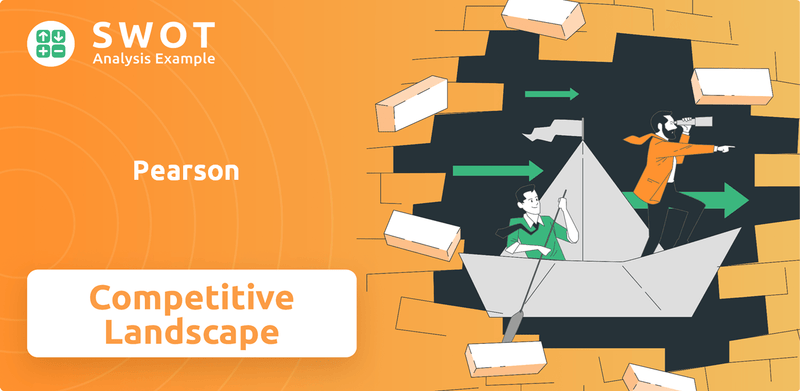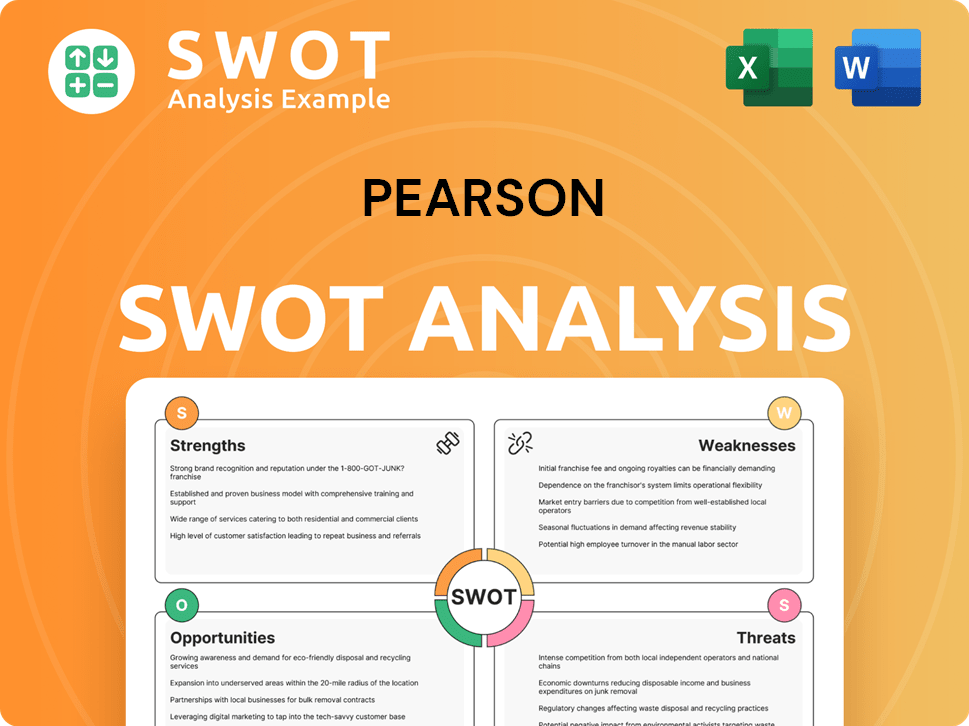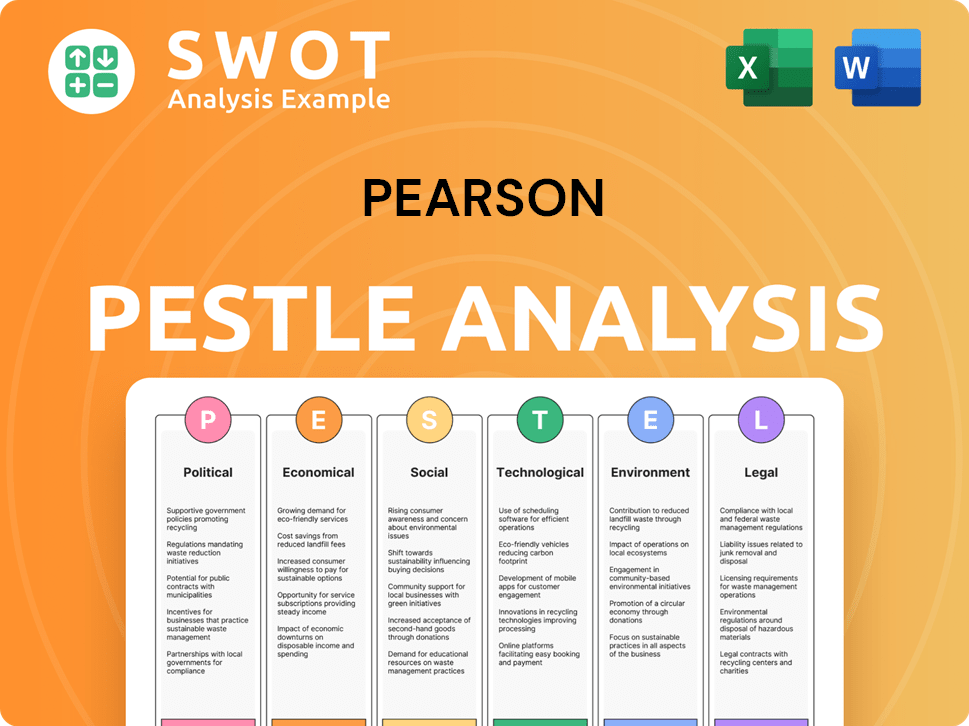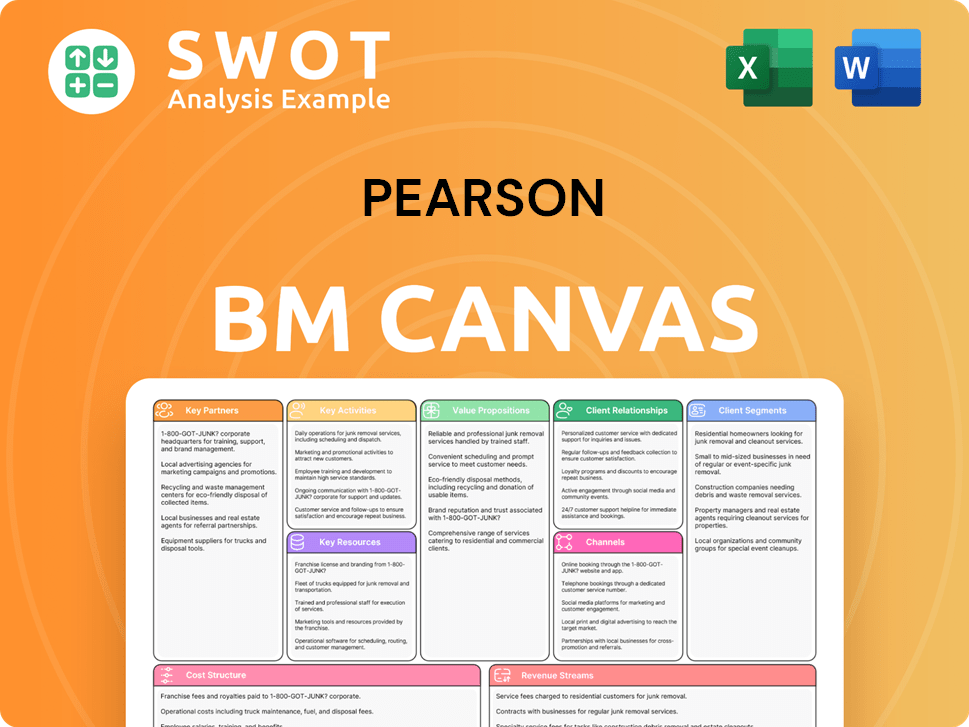Pearson Bundle
Can Pearson Conquer the Evolving Education Market?
The education industry is experiencing a seismic shift, fueled by digital advancements and changing student needs. Pearson, a global leader, has a long history, but how does it stack up against its rivals? Understanding the Pearson SWOT Analysis is key to navigating this complex terrain.

This article provides a deep dive into the Pearson competitive landscape, offering a comprehensive Pearson market analysis. We'll examine Pearson competitors and their strategies within the Education industry and Publishing market, particularly in Higher education. By exploring Pearson's strengths, weaknesses, and competitive advantages, we'll uncover its position in key markets, considering the impact of digital learning platforms and open educational resources.
Where Does Pearson’ Stand in the Current Market?
Pearson's core operations revolve around providing educational materials, assessment tools, and digital learning platforms globally. The company's value proposition lies in its comprehensive offerings that span across various educational segments, from K-12 to higher education and professional development. Pearson aims to enhance learning outcomes and support educators and learners worldwide through its diverse portfolio of products and services. The company's digital transformation strategy has been a key focus, shifting from traditional print-based publishing to a more digitally-focused learning company.
Pearson's market position is consistently strong within the global education and publishing industry. The company's financial performance in 2023, with an adjusted operating profit of £474 million and adjusted earnings per share of 50.8p, demonstrates its financial scale and stability. Pearson's revenue streams are diversified across virtual learning, higher education, English language learning, and workforce skills, catering to a wide range of customer segments including K-12 schools, universities, professional organizations, and individual learners. This diversification helps to mitigate risks and capitalize on various market opportunities.
Geographically, Pearson maintains a significant presence in over 200 countries and territories. The company's strategic focus on digital diversification, particularly in areas like online program management and virtual schools, has driven considerable growth. Pearson's ability to adapt its offerings to local educational needs in emerging economies, alongside its strong positions in developed markets like North America and the UK, contributes to its extensive market reach. The company's financial health, as evidenced by its 2023 performance, allows it to invest in new technologies and expand its digital offerings, further solidifying its market position.
Pearson is a major player in the global education market, though specific market share figures vary by segment. The company's revenue streams are diversified across virtual learning, higher education, English language learning, and workforce skills. The company's financial performance in 2023, with an adjusted operating profit of £474 million and adjusted earnings per share of 50.8p, demonstrates its financial scale and stability.
Pearson has significantly shifted towards digital offerings, with digital revenues representing 87% of total sales in 2023. This transformation includes investments in online program management and virtual schools. This strategic move has allowed the company to adapt to changing market demands and maintain a competitive edge in the education industry.
Pearson operates in over 200 countries and territories, demonstrating a strong global presence. The company has a significant presence in developed markets such as North America and the UK, while also expanding its reach in emerging economies. This global footprint allows Pearson to cater to a diverse range of customers and adapt to local educational needs.
Pearson's primary product lines include virtual learning, higher education, English language learning, and workforce skills. The company caters to a diverse range of customer segments, including K-12 schools, universities, professional organizations, and individual learners. This broad portfolio allows Pearson to capture a significant share of the education market.
Pearson's competitive advantages include its extensive portfolio of educational content, assessment tools, and digital learning platforms. The company's global presence and strong financial performance enable it to invest in new technologies and expand its digital offerings. The company's ability to adapt to local educational needs and its focus on digital diversification are also key strengths.
- Extensive Portfolio: A broad range of educational products and services.
- Global Presence: Operations in over 200 countries and territories.
- Digital Transformation: Strong focus on digital learning solutions.
- Financial Stability: Robust financial performance, allowing for investment and expansion.
Pearson SWOT Analysis
- Complete SWOT Breakdown
- Fully Customizable
- Editable in Excel & Word
- Professional Formatting
- Investor-Ready Format

Who Are the Main Competitors Challenging Pearson?
The Pearson competitive landscape is complex, encompassing a wide range of rivals across diverse educational sectors. The company faces competition from traditional publishers, digital learning platforms, and specialized providers. Understanding these competitors is crucial for analyzing Pearson's market analysis and strategic positioning within the education industry.
Pearson's competitors vary depending on the specific segment. In higher education and K-12, the company competes with established players such as McGraw Hill and Cengage. The rise of online learning has also introduced new competitors like 2U and Coursera. The competitive environment is dynamic, influenced by technological advancements, market consolidation, and evolving educational needs.
Pearson's competitive strategy analysis must consider the diverse challenges and opportunities presented by its rivals. Factors such as pricing, innovation, and market reach play critical roles in shaping the competitive dynamics. A thorough understanding of these elements is essential for Pearson's sustained success within the publishing market.
McGraw Hill and Cengage are key competitors in the higher education and K-12 sectors. These companies offer textbooks, digital learning platforms, and assessment solutions. They often compete directly with Pearson for textbook adoptions and digital platform contracts.
2U and Coursera are significant competitors in the OPM sector, partnering with universities to deliver online degree programs. They differentiate themselves through technology platforms, marketing reach, and revenue-sharing models. Recent consolidations in the OPM market are reshaping the competitive dynamics.
Pearson competes with a wide range of providers, including language schools like EF Education First and digital platforms such as Duolingo and Babbel. These platforms offer accessible and often gamified language learning experiences. The market is highly competitive, with many options for learners.
Pearson faces competition from professional bodies, specialized training providers, and emerging ed-tech companies. These entities offer skills-based learning and micro-credentials. The focus is on providing relevant skills for the workforce.
New and emerging players are leveraging AI and adaptive learning technologies. These companies aim to disrupt traditional models. They pose a significant threat to established publishers.
Mergers and alliances continually reshape competitive dynamics. Pearson must remain agile and strategically responsive. The market is subject to rapid change.
Pearson's competitive advantages include its established brand, extensive content library, and global reach. However, it faces challenges from competitors offering innovative digital solutions and competitive pricing. The company must adapt to changing market demands and technological advancements to maintain its position.
- Digital Learning Platforms: Competitors like McGraw Hill and Cengage invest heavily in digital platforms.
- Pricing Strategies: Competitive pricing is crucial in attracting customers.
- Innovation: The ability to innovate in educational content and technology is a key differentiator.
- Market Reach: Pearson's global presence is a strength, but competitors also have strong regional footprints.
Pearson PESTLE Analysis
- Covers All 6 PESTLE Categories
- No Research Needed – Save Hours of Work
- Built by Experts, Trusted by Consultants
- Instant Download, Ready to Use
- 100% Editable, Fully Customizable

What Gives Pearson a Competitive Edge Over Its Rivals?
The competitive advantages of the educational publisher are rooted in its extensive content library, strong brand reputation, global reach, and digital innovation focus. The company's vast repository of educational content, developed over decades, covers a wide array of subjects and learning levels. This intellectual property, including textbooks, assessment materials, and digital curricula, forms a significant barrier to entry for new competitors. Its brand carries substantial weight and trust within the educational community, fostering customer loyalty among institutions, educators, and learners worldwide.
The company's global distribution networks and established relationships with educational institutions across over 200 countries provide a substantial logistical and market access advantage. The company leverages these networks not only for traditional print materials but increasingly for the dissemination of its digital products and services. Its ongoing digital transformation is a crucial element of its competitive edge, with significant investments in adaptive learning technologies, AI-powered assessment tools, and virtual learning platforms.
The company's Pearson VUE business is a leading provider of computer-based testing, offering a secure and reliable platform for professional certifications and licensure exams. This technological infrastructure and expertise in assessment differentiate it from many smaller educational content providers. The company continues to leverage its brand and content to drive innovation, even as it evolves from its print-centric past to a more digitally-driven present. However, these advantages face threats from rapidly evolving technological landscapes and the emergence of agile, digital-native competitors who can quickly iterate and deploy new learning solutions.
The company has a long history, with key milestones including the acquisition of educational publishing businesses. They've expanded globally, establishing a strong presence in various international markets. The digital transformation has been a major focus, with significant investments in online learning platforms and assessment tools.
Strategic moves include divesting non-core assets to focus on education. They have been making acquisitions to strengthen their digital capabilities and expand their product offerings. Partnerships with technology companies and educational institutions are also a key part of their strategy.
Its competitive edge lies in its comprehensive content library and strong brand reputation. Global reach and established distribution networks are also significant advantages. The company's ongoing digital transformation and investments in adaptive learning technologies are crucial for maintaining its competitive position.
The company operates in the education industry, facing competition from various players in the publishing market. The higher education segment is a key area of focus, with significant market share. The company's competitive strategy involves a mix of traditional publishing and digital innovation.
The company's strengths include its extensive content library, brand recognition, and global presence. However, it faces challenges from digital-native competitors and the shift toward open educational resources. The company's ability to adapt to technological changes and maintain its market share is crucial.
- Content Library: A vast collection of educational materials across various subjects and levels.
- Brand Reputation: Strong trust and recognition within the educational community.
- Global Reach: Distribution networks and established relationships in over 200 countries.
- Digital Transformation: Investments in adaptive learning and AI-powered assessment tools.
Pearson Business Model Canvas
- Complete 9-Block Business Model Canvas
- Effortlessly Communicate Your Business Strategy
- Investor-Ready BMC Format
- 100% Editable and Customizable
- Clear and Structured Layout

What Industry Trends Are Reshaping Pearson’s Competitive Landscape?
The education industry is undergoing significant transformations driven by technology, changing learner expectations, and an emphasis on skills-based learning. This dynamic environment presents both challenges and opportunities for companies like Pearson. The increasing digitalization of education and the rise of new competitors are key factors shaping the Pearson competitive landscape.
Anticipated disruptions include the impact of AI on content creation, the growth of open educational resources (OERs), and shifts in traditional revenue models. Pearson's ability to adapt to these changes will be crucial for maintaining its market position. The Pearson market analysis reveals a need for strategic responses to maintain competitiveness.
Key trends include the accelerated adoption of artificial intelligence and adaptive learning technologies, the expansion of online and blended learning models, and a greater demand for personalized and lifelong learning. These trends are reshaping the education industry, creating both opportunities and challenges for established players.
Challenges include increased competition from ed-tech startups and tech giants, regulatory changes around data privacy, and the potential for AI to disrupt content creation and delivery. The decline in demand for traditional print textbooks and increased regulation on standardized testing also pose significant challenges. These factors impact the Pearson competitive landscape.
Opportunities include the growing demand for workforce skills development and professional certifications, expansion in emerging markets (Asia and Africa), and strategic partnerships with technology companies and educational institutions. Leveraging its assessment expertise and expanding B2C offerings are also key. These opportunities can help Pearson to strengthen its market position.
Strategies include accelerating digital transformation, investing in AI and data analytics, expanding B2C offerings, and pursuing strategic acquisitions. Focusing on workforce skills and virtual learning is also crucial. Pearson aims to adapt to the evolving industry dynamics and maintain a competitive edge.
Pearson's strengths include a well-established brand, extensive content library, and global reach. Weaknesses include the need to adapt to rapid technological changes and increased competition. The company's ability to innovate and respond to market changes will be critical for future success. Understanding the Pearson competitors is essential.
- Strengths: Strong brand recognition, global presence, and a vast content library.
- Weaknesses: Dependence on traditional publishing, slow adaptation to digital trends, and high operational costs.
- Opportunities: Growth in online learning, demand for skills-based training, and expansion in emerging markets.
- Threats: Competition from ed-tech companies, declining print textbook sales, and changing regulatory environment.
To maintain its competitive edge, Pearson must focus on digital transformation, strategic acquisitions, and expanding its B2C offerings. For a deeper dive into how Pearson generates revenue, explore the Revenue Streams & Business Model of Pearson.
Pearson Porter's Five Forces Analysis
- Covers All 5 Competitive Forces in Detail
- Structured for Consultants, Students, and Founders
- 100% Editable in Microsoft Word & Excel
- Instant Digital Download – Use Immediately
- Compatible with Mac & PC – Fully Unlocked

Related Blogs
- What are Mission Vision & Core Values of Pearson Company?
- What is Growth Strategy and Future Prospects of Pearson Company?
- How Does Pearson Company Work?
- What is Sales and Marketing Strategy of Pearson Company?
- What is Brief History of Pearson Company?
- Who Owns Pearson Company?
- What is Customer Demographics and Target Market of Pearson Company?
Disclaimer
All information, articles, and product details provided on this website are for general informational and educational purposes only. We do not claim any ownership over, nor do we intend to infringe upon, any trademarks, copyrights, logos, brand names, or other intellectual property mentioned or depicted on this site. Such intellectual property remains the property of its respective owners, and any references here are made solely for identification or informational purposes, without implying any affiliation, endorsement, or partnership.
We make no representations or warranties, express or implied, regarding the accuracy, completeness, or suitability of any content or products presented. Nothing on this website should be construed as legal, tax, investment, financial, medical, or other professional advice. In addition, no part of this site—including articles or product references—constitutes a solicitation, recommendation, endorsement, advertisement, or offer to buy or sell any securities, franchises, or other financial instruments, particularly in jurisdictions where such activity would be unlawful.
All content is of a general nature and may not address the specific circumstances of any individual or entity. It is not a substitute for professional advice or services. Any actions you take based on the information provided here are strictly at your own risk. You accept full responsibility for any decisions or outcomes arising from your use of this website and agree to release us from any liability in connection with your use of, or reliance upon, the content or products found herein.